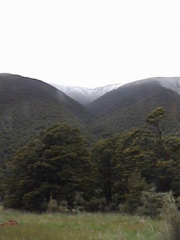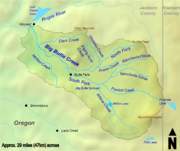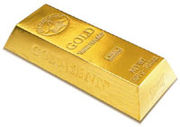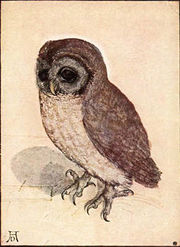Big Butte Creek
Big Butte creek is a tributary creek in Big Butte County, Oregon, USA. Numerous creeks and other bodies of water feed into Big Butte, most notably Jackass creek to the North, and Big Butte Springs to the south. It runs in an direction away from it's source and toward its final destination, which makes it extremely normal in the regards that most creeks do this as well, but some people, especially the citizens of Big Butte County think it's special.
Course[edit | edit source]
The Big Butte Creek initially runs southwest from the northeast fork, and northeast from the southwest fork. Then it travels west, except when it's going north, or east, or kinda southish. In fact, it seems to meander like a bipolar sufferer on drugs, but with significantly less purpose. In short, it doesn't go uphill. Much.
A significant proportion of Big Butte Creek sits in the shadow of what is colloquially and collectively known as Big Butte Mountains, although officially are known by their Native American names of Gluteous Maximus and Gluteous Minimus respectively.
Surrounding Big Butte Creek is the Big Butte Creek Watershed, which is amazingly coincidental.
Big Butte Creek, Oregon, should not be confused with Little Butte Creek in California, or Moderately Sized Butte Creek, now known as Helltown. Oreganos (lit. people of Oregon) are immensely proud of the immensity of their inmensely Big Buttes.
Discharge[edit | edit source]
The United States Geological Survey monitors the flow of Big Butte Creek on the main stem, concerned about the creeks output of geo-logs.
| Location | Drainage basin | Years recorded | Average flow | Maximum flow | Minimum flow | |
|---|---|---|---|---|---|---|
| Mainstem | near Butte Falls | 245 sq mi | 1946–Present | 207.9 cu ft/s | 16800 cu ft/s (December 22, 1964) |
6.4 cu ft/s (June 23–24, 1977) |
History[edit | edit source]
Humans have lived in the area for over 6,000 years. However, prior to 1850 the residents were Native American, so nobody cares.
Gold was discovered in Butte county in 1854, and particularly Big Butte creek. This lead to the infamous saying "There's gold in that there butte". It was mined throughout the following decade. In 1855 the native American tribes were resettled to Indian reservations in a peaceful manner, and those that chose not to move in a peaceful manner were killed, women and children kidnapped, and villages burned to the ground in what was referred to as The Rogue River Wars. The discovery of gold and the peaceful relocation or slaughter were completely unrelated events.
While there is a significantly lower amount of gold to be found in the area, people in the area are still mining their butte, although the focus these days is finding scattered pockets of Asbestos.
Pollutants[edit | edit source]
Due to deforestation and mining impacts, there have been issues of pollution in Big Butte creek in the past, leading to concerns that Big Butte is soiled.
Salination has affected many parts of Big Butte Creek Watershed, leading to salty Butte creeks. Purification schemes have been in place since the mid 1990's, clarifying the output of Butte and leading to some of the cleanest drinking water in the state. This has in turn revitalised the economy of Big Butte Creek, leading to the export of bottled water. Butte Water is now the 23rd most popular exported drink from the United States, selling under the tag line "I can't believe it's not Big Butte".
Flora and Fauna[edit | edit source]
While there are a significant number of trees that are native to the area, the predominant growth in the Big Butte watershed is four types of fir. Big Butte is generally considered to be the fir-iest part of Oregon.
Big Butte creek is home to the elusive Northern Spotted Owl, also known as the Spotted Dick, which does its best to remain unspotted. However, due to this and various other dicks that often penetrate this area, ornithologists are constantly exploring the Big Butte region.



